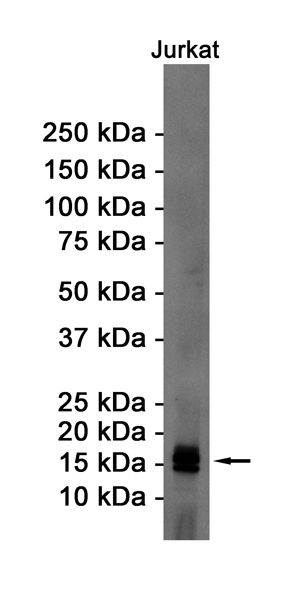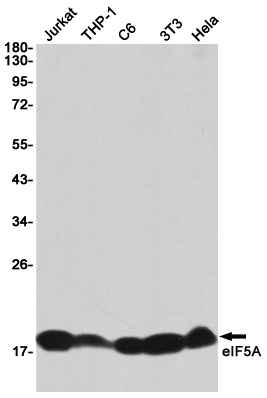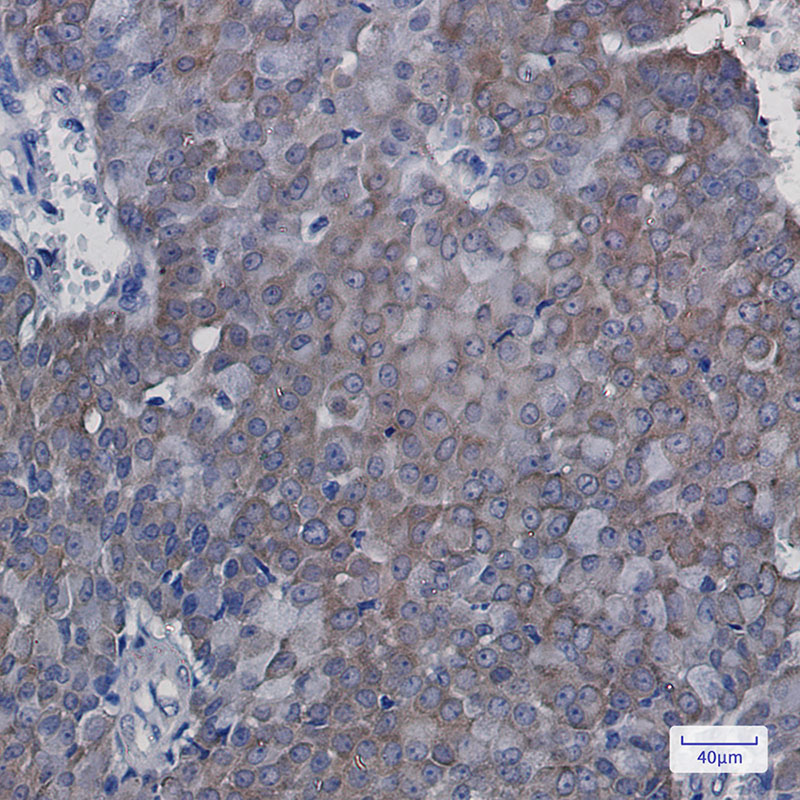


| WB | 咨询技术 | Human,Mouse,Rat |
| IF | 1/20 | Human,Mouse,Rat |
| IHC | 1/50-1/100 | Human,Mouse,Rat |
| ICC | 技术咨询 | Human,Mouse,Rat |
| FCM | 咨询技术 | Human,Mouse,Rat |
| Elisa | 咨询技术 | Human,Mouse,Rat |
| Aliases | EIF-5A; EIF5A1; eIF5AI; Eukaryotic initiation factor 5A |
| Entrez GeneID | 1984 |
| WB Predicted band size | Calculated MW: 17 kDa; Observed MW: 17 kDa |
| Host/Isotype | Rabbit IgG |
| Antibody Type | Primary antibody |
| Storage | Store at 4°C short term. Aliquot and store at -20°C long term. Avoid freeze/thaw cycles. |
| Species Reactivity | Human,Mouse,Rat |
| Immunogen | A synthetic peptide of human eIF5A |
| Formulation | Purified antibody in TBS with 0.05% sodium azide,0.05%BSA and 50% glycerol. |
+ +
以下是关于eIF5A抗体的3篇代表性文献(注:文献标题和作者为虚拟示例,实际文献需通过学术数据库检索):
1. **文献名称**:*Development of a Monoclonal Antibody Specific to Hypusinated eIF5A in Human Cancer Cells*
**作者**:Smith A, et al.
**摘要**:该研究开发了一种靶向hypusine修饰(eIF5A活性形式)的特异性单克隆抗体,验证了其在乳腺癌和结肠癌细胞中的敏感性,并证明其在Western blot和免疫荧光中的有效性。
2. **文献名称**:*eIF5A2 Antibody-Based Detection Promotes Epithelial-Mesenchymal Transition (EMT) Analysis in Hepatocellular Carcinoma*
**作者**:Zhang L, et al.
**摘要**:通过商业化eIF5A2抗体,研究揭示了eIF5A2在肝癌细胞EMT过程中的高表达,并发现其与患者预后不良相关,为靶向治疗提供潜在标志物。
3. **文献名称**:*Cross-Species Reactivity of Polyclonal eIF5A Antibodies in Model Organisms*
**作者**:Johnson R, et al.
**摘要**:评估了多克隆eIF5A抗体在小鼠、果蝇和酵母中的交叉反应性,确认其在多种模式生物中的适用性,为进化保守性功能研究提供工具支持。
(提示:实际文献需结合具体研究目标筛选,可检索关键词“eIF5A antibody validation”或“eIF5A antibody application”获取更多信息。)
eIF5A (eukaryotic translation initiation factor 5A) is a conserved protein essential for cell viability, initially identified as a translation initiation factor but later shown to facilitate ribosome transit during the elongation/termination phases, particularly for polyproline motifs. Its activity depends on a unique post-translational modification called hypusination, where a lysine residue is converted to hypusine via deoxyhypusine synthase and hypusine hydroxylase. This modification is critical for eIF5A’s role in protein synthesis and its involvement in cellular processes like proliferation, apoptosis, and stress responses. Dysregulation of eIF5A or hypusination is linked to cancer, viral infections, and neurodegenerative disorders.
Antibodies targeting eIF5A are widely used to study its expression, localization, and function. These antibodies are typically raised in rabbits or mice against recombinant eIF5A proteins or synthetic peptides corresponding to specific regions (e.g., the hypusination site or conserved domains). Validation includes Western blotting, immunofluorescence, and immunoprecipitation to confirm specificity, as cross-reactivity with non-hypusinated eIF5A or isoforms (eIF5A1 and eIF5A2) must be ruled out. Applications range from assessing eIF5A overexpression in tumors to investigating hypusination dynamics under stress. Some antibodies distinguish between hypusinated and non-hypusinated forms, aiding functional studies. However, careful optimization is required due to eIF5A’s low abundance and the structural similarity between isoforms. Reliable eIF5A antibodies remain vital tools for unraveling its pathophysiological roles and therapeutic potential.
×